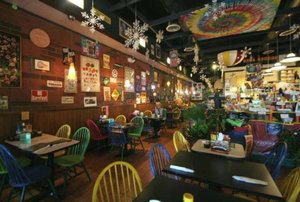Advertisement
Published: January 2nd 2016

 Dancing Avocado Kitchen
Dancing Avocado Kitchen
Signs on the walls lend the place a 60s feel.Our first stop on downtown Daytona’s historic main drag, was the Dancing Avocado Kitchen, where both the fare and the décor hearken back to the 1960s. I ordered a toasted cheese and avocado sandwich with a side of shredded broccoli stems. Nancy treated herself to the sprouted lentil salad.
Old street signs, bumper stickers, and posters festoon the walls of the Dancing Avocado. My fave? "Stop! Forrest! Stop!” (Think Forrest Gump, the movie). Curious about the ambiance of the place, I asked the waitress if it had been there since the '60s. “No,” she said, "We’ve only been in business 18 years."
After lunch, we strolled two blocks south to the Halifax Historical Museum, located in what was once the old Merchant’s Bank Building. The building, which opened in 1911, is itself a piece of Daytona history. It went belly up when the Stock Market crashed in 1929, then returned for a couple more incarnations as a bank (and as a restaurant called “
The Bank”), before it was finally bought by Volusia County and converted into the museum in 1986.
We sat and watched a video on Daytona history, with
its sad tale of the Timucua Indians who lived in the area from a time when giant ground sloths still roamed the earth, until the Spanish showed up in 1565 and turned them into slaves. But it was the British, who took over in 1763, who finally exhausted them into oblivion.
On a happier note, we were captivated by the story of Brownie the Town Dog, who wandered onto Beach Street in 1940, and was such a friendly fellow that he was adopted by the locals who fed him, built him a dog house, and even set up a bank account in his name. By the time he passed on to doggie heaven in 1954, there was enough cash in his account to build him a coffin and buy him a headstone. He's buried in Riverfront Park, just across Beach Street from the Museum.
By the time we made it to the Angell and Phelps Chocolate Factory, located a block north of the Museum, it was already past 4:00 and the last tour of the facilities was just winding down. We got in line for the free samples anyway. The factory, we learned,
was founded in 1925 by two enterprising gals from Mackinac Island, Michigan. Sunny Florida must have looked way more appealing than frosty Michigan, because at the onset of WW2 our gals pulled up stakes and moved their entire kit and caboodle to Daytona Beach. The relocation presented them with a whole new set of challenges, mainly because air conditioning had not yet been invented, which meant the chocolates kept melting. Somehow they figured it out, because their factory is still in business and doing quite well, considering the joint was wall-to-wall when we were there, and the seasonal tourists had not yet begun to arrive.
Angell and Phelps specializes in oddball combinations, like chocolate covered bacon, Twinkies, and potato chips. They also feature chocolates in the shapes of hammers, screw drivers, and eggs, sunny side up. We could not resist. We bought way more than was good for us and, munching happily, made our way back down Beach Street to the car.
Advertisement
Tot: 0.095s; Tpl: 0.015s; cc: 9; qc: 30; dbt: 0.0422s; 1; m:domysql w:travelblog (10.17.0.13); sld: 1;
; mem: 1mb

 Dancing Avocado Kitchen
Dancing Avocado Kitchen